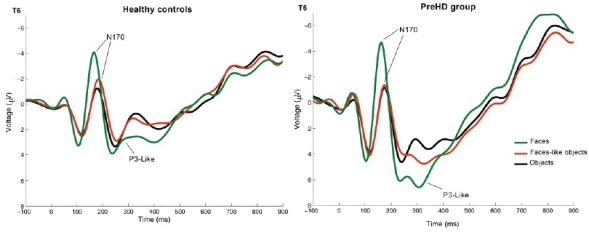Session Information
Date: Wednesday, June 22, 2016
Session Title: Huntington's disease
Session Time: 12:00pm-1:30pm
Location: Exhibit Hall located in Hall B, Level 2
Objective: To investigate the behavioral and neurophysiological correlates of face and face-like-object recognition in premanifest Huntington’s disease (preHD).
Background: PreHD provide an excellent framework to study changes preceding the clinical onset of HD. Posterior-cortical thinning is measurable 15 years before motor diagnosis, but little is known about its functional implications. Face perception involve posterior-cortical territories which could be early affected by the progression of HD. The n170 -an event-related brain potential (ERP) elicited by faces and face-like objects and recorded on occipito-temporal sites- constitute an objective measure to assess the functional integrity of systems involved in this function.
Methods: Eleven preHD and 11 gene-negative controls participated in the study. EEG was obtained from 19 standard locations (10/20). Stimuli consisted of 105 pictures (neutral faces, face-like-objects and non-face-like objects). Additional assessments included the UHDRS Cogscore, the Benton’s Facial Recognition test, the Problems Behaviour Assessment and the Apathy Evaluation Scale (AES).
Results: PreHD scored significantly higher on AES (8.4±8.7 vs 0;p=.04). Whereas no differences were seen for faces and non-face-like objects recognition, preHD exhibited a significant higher number of errors on face-like-objects recognition (27±11 vs 5±3;p=.002). ERPs showed an increased amplitude of the n170 component elicited for faces in preHD and a complete abolition of the n170 component elicited for faces-like-objects followed by a significant higher amplitude of a p3-like component. Correlation analysis showed a strong relation between the amplitude of the n170 component and error rate (r=-0.721;p=.008), cogscore (r=-0.663;p=.01) and apathy score (r=-0.677;p=.01) and p3-like and correct responses for faces-like-objects in preHD (r=0.641;p=.02). 
Conclusions: In preHD facial recognition is enhanced by compensatory mechanisms reflected as an increase of the n170. These mechanisms are inefficient in front of higher cognitive load promoted by face-like-object processing where alternative resources seems to be insufficiently engaged. Specific posterior-cortical functional alterations and related behavioral performance characterizes preHD individuals and is linked to clinical measures related to disease progression.
To cite this abstract in AMA style:
S. Martinez-Horta, J. Perez-Perez, A. Horta-Barba, R. Fernandez-Bobadilla, J. Pagonabarraga, J. Kulisevsky. Neurophysiological evidence of posterior-cortical alterations in premanifest Huntington’s: An event-related brain potentials study of face and face-like objects processing [abstract]. Mov Disord. 2016; 31 (suppl 2). https://www.mdsabstracts.org/abstract/neurophysiological-evidence-of-posterior-cortical-alterations-in-premanifest-huntingtons-an-event-related-brain-potentials-study-of-face-and-face-like-objects-processing/. Accessed December 6, 2025.« Back to 2016 International Congress
MDS Abstracts - https://www.mdsabstracts.org/abstract/neurophysiological-evidence-of-posterior-cortical-alterations-in-premanifest-huntingtons-an-event-related-brain-potentials-study-of-face-and-face-like-objects-processing/
